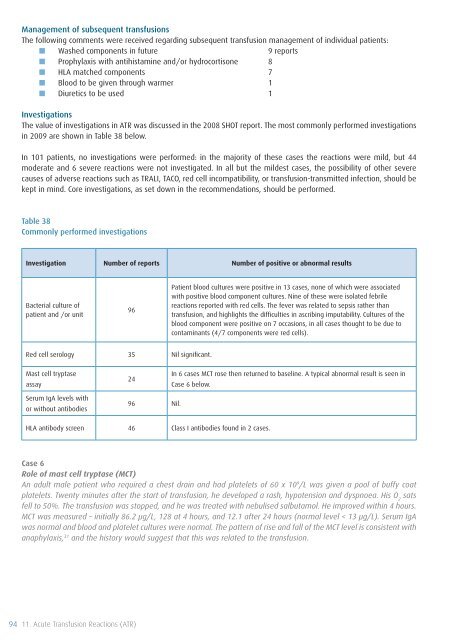SHOT Annual Report 2009 - Serious Hazards of Transfusion
SHOT Annual Report 2009 - Serious Hazards of Transfusion
SHOT Annual Report 2009 - Serious Hazards of Transfusion
You also want an ePaper? Increase the reach of your titles
YUMPU automatically turns print PDFs into web optimized ePapers that Google loves.
Management <strong>of</strong> subsequent transfusions<br />
The following comments were received regarding subsequent transfusion management <strong>of</strong> individual patients:<br />
■■ Washed components in future<br />
9 reports<br />
■■ Prophylaxis with antihistamine and/or hydrocortisone 8<br />
■■ HLA matched components 7<br />
■■ Blood to be given through warmer 1<br />
■■ Diuretics to be used 1<br />
Investigations<br />
The value <strong>of</strong> investigations in ATR was discussed in the 2008 <strong>SHOT</strong> report. The most commonly performed investigations<br />
in <strong>2009</strong> are shown in Table 38 below.<br />
In 101 patients, no investigations were performed: in the majority <strong>of</strong> these cases the reactions were mild, but 44<br />
moderate and 6 severe reactions were not investigated. In all but the mildest cases, the possibility <strong>of</strong> other severe<br />
causes <strong>of</strong> adverse reactions such as TRALI, TACO, red cell incompatibility, or transfusion-transmitted infection, should be<br />
kept in mind. Core investigations, as set down in the recommendations, should be performed.<br />
Table 38<br />
Commonly performed investigations<br />
Investigation Number <strong>of</strong> reports Number <strong>of</strong> positive or abnormal results<br />
Bacterial culture <strong>of</strong><br />
patient and /or unit<br />
96<br />
Patient blood cultures were positive in 13 cases, none <strong>of</strong> which were associated<br />
with positive blood component cultures. Nine <strong>of</strong> these were isolated febrile<br />
reactions reported with red cells. The fever was related to sepsis rather than<br />
transfusion, and highlights the difficulties in ascribing imputability. Cultures <strong>of</strong> the<br />
blood component were positive on 7 occasions, in all cases thought to be due to<br />
contaminants (4/7 components were red cells).<br />
Red cell serology 35 Nil significant.<br />
Mast cell tryptase<br />
assay<br />
24<br />
In 6 cases MCT rose then returned to baseline. A typical abnormal result is seen in<br />
Case 6 below.<br />
Serum IgA levels with<br />
or without antibodies<br />
96 Nil.<br />
HLA antibody screen 46 Class I antibodies found in 2 cases.<br />
Case 6<br />
Role <strong>of</strong> mast cell tryptase (MCT)<br />
An adult male patient who required a chest drain and had platelets <strong>of</strong> 60 x 10 9 /L was given a pool <strong>of</strong> buffy coat<br />
platelets. Twenty minutes after the start <strong>of</strong> transfusion, he developed a rash, hypotension and dyspnoea. His O 2<br />
sats<br />
fell to 50%. The transfusion was stopped, and he was treated with nebulised salbutamol. He improved within 4 hours.<br />
MCT was measured – initially 86.2 µg/L, 128 at 4 hours, and 12.1 after 24 hours (normal level < 13 µg/L). Serum IgA<br />
was normal and blood and platelet cultures were normal. The pattern <strong>of</strong> rise and fall <strong>of</strong> the MCT level is consistent with<br />
anaphylaxis, 31 and the history would suggest that this was related to the transfusion.<br />
94 11. Acute <strong>Transfusion</strong> Reactions (ATR)












